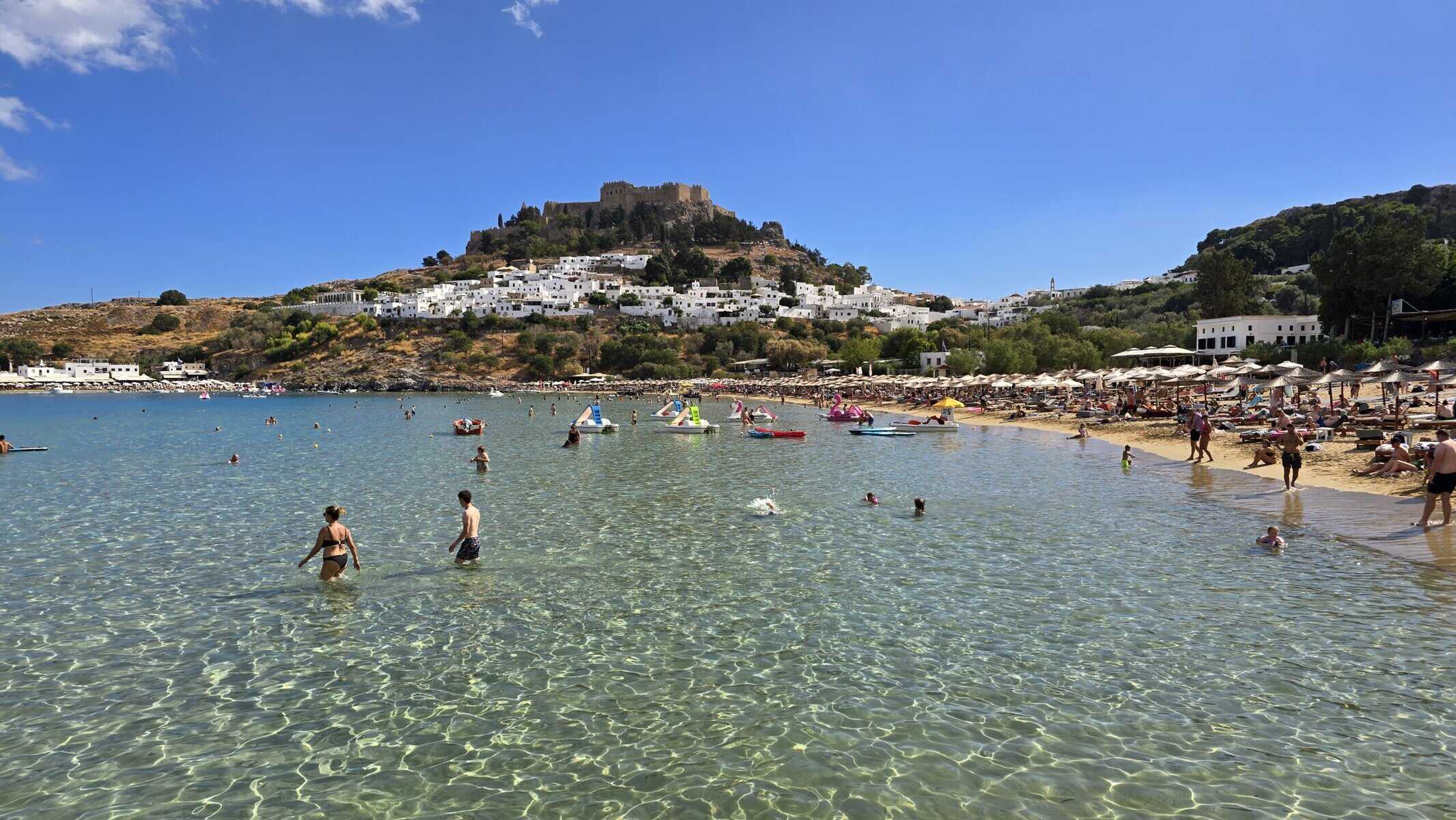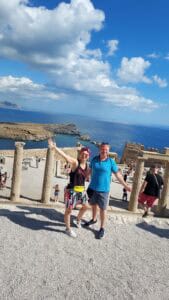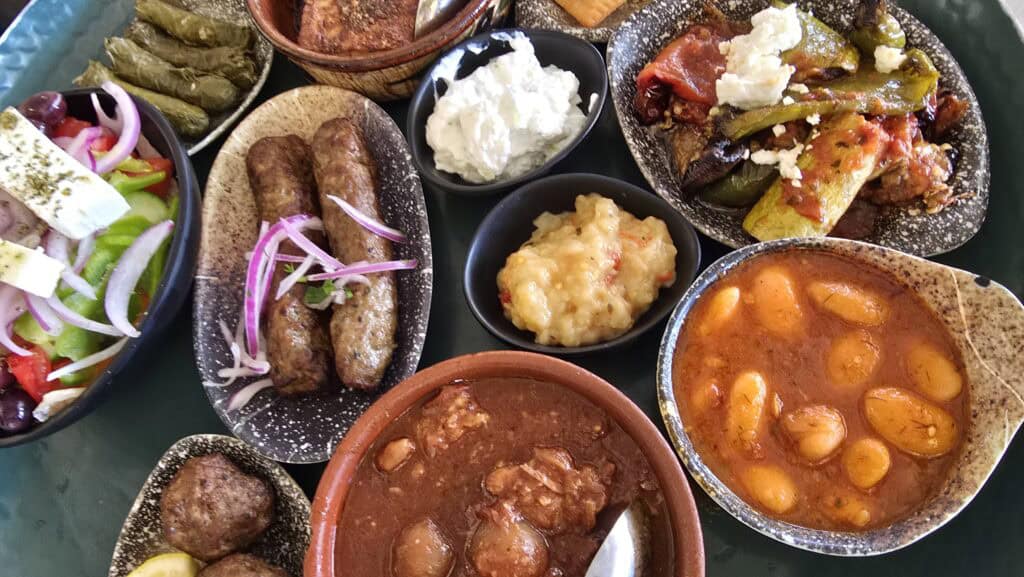When to Visit Rhodes, Greece: A Month-by-Month Guide
When exactly is the best time to visit Rhodes, Greece, without the suffocating summer crowds or chilly off-season closures?
Rhodes is an incredible year-round destination, but knowing the perfect time to go is crucial for enjoying the beaches and historical sites fully. This isn’t just a generic month-by-month breakdown; this is an expert seasonal guide based on real-world experience. From the ideal swimming temperatures in the shoulder months to advice on when to skip the trip altogether, here is a complete guide to finding your perfect travel window on this magnificent Greek island.
Table of Contents for When to Visit Rhodes, Greece
Rhodes in January
January is the coldest and wettest month in Rhodes. Average temperatures range from 8°C (46°F) to 15°C (59°F). Days are often cloudy and rainy, but there are also moments of sunshine.
Can you swim in Rhodes in January? No, swimming is out of the question due to low air and water temperatures.
What to do: The island is very quiet, with most tourist activities closed. It’s the perfect time for history and archaeology lovers. You can explore the Old Town of Rhodes, and the ancient sites of Kamiros and Ialyssos in complete solitude. The atmosphere is authentic and far from the summer rush. What to eat: This is the ideal time to enjoy hearty, traditional dishes like stifado (beef stew with onions) or fasolada (a rich bean soup) in a local taverna to stay warm. Ideal for: Solo travelers, history buffs, and anyone seeking an authentic, peaceful experience.
Rhodes in February
February is similar to January, with temperatures ranging from 9°C (48°F) to 16°C (61°F). The rain starts to decrease slightly, and nature begins to awaken with the first flowers blooming.
Can you swim in Rhodes in February? No, swimming is still impossible due to the cold.
What to do: Conditions are great for hiking and walks. Trails like the Valley of the Seven Springs are green and lush. Many traditional restaurants in the smaller villages remain open, offering a genuine taste of local life. What to eat: Try authentic island dishes based on meat and seasonal vegetables, such as giouvetsi (baked meat with orzo pasta). Ideal for: Hikers, photographers, and those who want to discover the hidden soul of Rhodes.
Rhodes in March
March marks the beginning of spring. Temperatures rise to 11°C (52°F) – 18°C (64°F) and sunny days become more frequent. Rain significantly decreases, and the island becomes vibrant with wild anemones and orchids.
Can you swim in Rhodes in March? No, the sea water is still too cold for swimming.
What to do: It’s the perfect month for a full exploration without the crowds. You can visit the Acropolis of Lindos, the thermal baths of Kalithea, or take scenic drives along the coast. The beaches are perfect for long walks. What to eat: The cuisine begins to offer lighter dishes with fresh spring vegetables, like spanakopita (savory spinach pie) or the first dolmades (stuffed vine leaves). Ideal for: Cyclists, nature lovers, and anyone looking for an active trip before the high season.
Rhodes in April
April is a wonderful month. Temperatures stabilize between 14°C (57°F) and 21°C (70°F), and rain is rare. The first tourists start to arrive, and the island prepares for summer.
Can you swim in Rhodes in April? The sea water is still fresh for most, but those from colder climates like the UK or Northern Europe might find it bracing enough for a quick dip.
What to do: Most restaurants and bars reopen. The days are perfect for exploring the Old Town or major attractions. Ferries to nearby islands start operating regularly again. What to eat: It’s the ideal time to enjoy the first wild greens (horta) salads and fresh fish, which becomes more abundant. Ideal for: Those seeking a balance between peace and exploration, couples, and families with young children.
Rhodes in May
May is a fantastic month to visit. Temperatures are ideal (17°C/63°F – 25°C/77°F), and the island isn’t crowded yet. Days are long and sunny with almost no rain.
Can you swim in Rhodes in May? Yes, the sea water is warm enough for swimming and very pleasant.
What to do: It’s the perfect month to enjoy the beaches. You can explore famous spots like Faliraki or Anthony Quinn Bay before they get crowded. You can also rent a car to discover hidden coves and small inland villages. What to eat: The local cuisine shines with fresh products like new olive oil, early summer vegetables, and local cheeses served with honey. Ideal for: Anyone looking for the perfect mix of sun, sea, and culture.
Rhodes in June
June is the prelude to the high season. Temperatures rise significantly (21°C/70°F – 29°C/84°F) and days are very long and sunny. Rain is non-existent.
Can you swim in Rhodes in June? Yes, the sea water is wonderfully warm and perfect for swimming.
What to do: The island is fully active. All bars and restaurants are open, and the nightlife starts to pick up. You can enjoy water sports or go on boat trips to explore the coast and nearby islands like Symi. What to eat: This is a paradise for fresh fish and grilled meats. Don’t miss out on souvlaki or grilled octopus at a seaside taverna. Ideal for: Summer lovers, nightlife enthusiasts, and those who enjoy beach activities.
Rhodes in July
July is one of the hottest and busiest months. Temperatures easily exceed 30°C (86°F) and humidity is high. Rain is a distant memory, and the island is buzzing with life.
Can you swim in Rhodes in July? Yes, the sea is warm and crystal clear, making it perfect for a refreshing dip.
What to do: The main activities revolve around the sea. Beaches are crowded, but the water is perfect. It’s the ideal month for nightlife, beach clubs, and boat trips. In the Valley of Butterflies, you can witness the famous butterfly migration. What to eat: Cool down with a fresh horiatiki (Greek salad) and a glass of chilled Ouzo or Tsipouro. Ideal for: Party lovers, families looking for fun, and anyone who wants a full summer experience.
Rhodes in August
August is the peak of the high season. It’s the hottest month of the year, with temperatures often above 30°C (86°F). The island is packed and the atmosphere is vibrant.
Can you swim in Rhodes in August? Yes, swimming is a must. The conditions are absolutely perfect.
What to do: The main focus is on beach life and nightlife. All attractions are open and restaurants are fully booked. It’s highly recommended to book everything in advance. What to eat: This is the perfect time to enjoy the freshest fish, such as grilled sea bream or red snapper, and share a variety of mezé (appetizers). Ideal for: Those seeking maximum fun, lovers of crowds and nightlife, and those who don’t mind high temperatures.
Rhodes in September
September is one of the best months to visit Rhodes. The weather is still summery, but temperatures are milder (21°C/70°F – 29°C/84°F), and the island gradually empties out. Rain is rare.
Can you swim in Rhodes in September? Yes, the sea water is still very warm and inviting.
What to do: You can enjoy the beaches with more tranquility. Conditions are ideal for combining beach days and cultural exploration. The nightlife is still active but less chaotic. What to eat: It’s a great time to enjoy late-summer fruits like fresh figs and grapes. Ideal for: Couples, sea lovers seeking relaxation, and those who want a summer experience without the crowds of July and August.
When to go to Rhodes? September is the ideal month for temperatures and relaxation
Based on weather observations recorded in late September 2025, the island of Rhodes confirms itself as an ideal destination for extending the summer. Temperatures remain at very pleasant levels, with highs consistently fluctuating between 27 and 29°C and evening lows not dropping below 21-22°C, making the climate perfect for enjoying every moment of the day.
The probability of rain is minimal, and the days are predominantly sunny, allowing for all outdoor activities without interruption. The climate trend of this period foreshadows an October that, while marking the transition to autumn, retains a mild and welcoming character, with temperatures that will gradually drop but will remain high enough for a relaxing holiday.
Rhodes in October
October is a great transitional month. Temperatures drop slightly (17°C/63°F – 24°C/75°F) but the climate remains pleasant. Rain starts to become more frequent, especially towards the end of the month.
Can you swim in Rhodes in October? Yes, the sea water is still warm and perfect for a swim. This is also a popular month for visitors from colder countries who appreciate the pleasant temperatures both in and out of the water.
What to do: It’s the perfect month to combine swimming and cultural visits. The beaches are almost deserted, and historical attractions are much more enjoyable. What to eat: You can still find summer dishes, but tavernas also begin offering heartier flavors, like traditional stifado, preparing for the change of season. Ideal for: Anyone who loves peace and quiet, couples, and those looking for a balance between relaxation and culture.
To learn more about Rhodes in October and discover activities for this month, check out the following article.
Rhodes in November
November marks the beginning of the low season. Temperatures drop (13°C/55°F – 20°C/68°F) and rain increases. The island slowly shuts down, with many hotels and restaurants closing for the winter.
Can you swim in Rhodes in November? No, swimming is nearly impossible due to the low temperatures.
What to do: It’s the ideal time for those seeking an authentic experience. You can explore the Old Town in total peace and discover traditional villages. The atmosphere is relaxed and the air is fresh, perfect for long walks. What to eat: In the open tavernas, you can enjoy authentic winter cuisine with dishes like moussaka and meat and root vegetable specialties. Ideal for: Photographers, history lovers, and anyone looking for a non-touristy experience.
Rhodes in December
December is a winter month, with temperatures between 10°C (50°F) and 17°C (63°F). Rain is frequent, but there are also sunny days. The Christmas atmosphere is present but on a much quieter scale than in other European destinations.
Can you swim in Rhodes in December? No, the sea water is cold, and swimming is not recommended for anyone.
What to do: Many attractions are closed or have reduced hours. The island is very quiet. It’s a great time to experience local traditions, visit museums, and enjoy the cuisine in small, family-run tavernas. What to eat: Don’t miss out on traditional Christmas sweets like melomakarona (honey cookies) and kourabiedes (butter cookies with almonds). Ideal for: Those seeking a winter getaway from the cold, culture lovers, and anyone wanting to discover the more intimate side of Rhodes.
My Personal Take: Why I Chose Late September/Early October for Rhodes
After analysing the weather month-by-month, my personal trip to Rhodes was scheduled for late September and early October, and it proved to be the ideal choice.
This specific period provides the perfect sweet spot for an island getaway. The sea is still comfortably warm—perfect for swimming—and the air is pleasantly warm without the scorching heat of mid-summer. We could easily spend hours on the beach without feeling suffocated by the sun.

The most significant advantage was the absence of peak-season crowds. While there were still people around, we enjoyed the freedom of choosing a spot on the beautiful free beaches, and we didn’t feel the pressure to constantly rent sunbeds or wait in long queues. Exploring historical sites like the Acropolis of Lindos was infinitely better without the summer rush.
Furthermore, all local services—from restaurants to tour operators—were still fully available, giving us the freedom to choose between beach time, sightseeing, or enjoying local restaurants, but with a more relaxed atmosphere.
If you are planning your trip, I highly recommend opting for the shoulder months (late September, October, and May/early June). They offer the full, fantastic experience of sunbathing and exploring without the overwhelming summer crowds, allowing you to truly savour the island’s unique character.
Rhodes vs. Delos: The Shoulder Season Advantage for Historical Sites
This comfortable visit to the Acropolis of Lindos in early October stands in stark contrast to our previous experience exploring the archaeological sites of Delos in early August.

When we visited Delos during the peak summer, we were forced to adjust our itinerary significantly. Even in the late afternoon, the heat was still intense, making our exploration of the ancient ruins physically draining and less enjoyable.
Rhodes in October, however, offered a completely different story: we could visit historical landmarks like the Acropolis at 11:30 AM—the height of the midday sun—and remain comfortable. This freedom to choose our sightseeing schedule, without having to surrender to the brutal summer heat, highlights the true value of travelling during the shoulder seasons.
(You can read more about our experience and tips for visiting the other ancient island here: Historical Things to Do in Mykonos: Delos – Apollo’s Island).
When to AVOID Visiting Rhodes (And Why)
While Rhodes can be visited year-round, based on our experience, we would personally advise against travelling during the deep winter months: November, December, January, and February.
The sea is a major attraction in Rhodes, and during these months, the weather is often too cold for swimming or relaxing comfortably on the beaches. While many historical sites, like the Old Town, remain open, the overall experience can feel muted when you can’t enjoy the island’s magnificent coastline and waters.
Visiting during the peak shoulder season (like late September/early October or May/early June) allows you to enjoy the best of both worlds: comfortable temperatures, fewer crowds, and the ability to swim. Plus, the prices in the shoulder months are often much more affordable than the peak summer, making them a far better value proposition for a complete Rhodes experience.
While July and August guarantee the best beach weather, we personally advise against visiting during these two peak months if you are seeking a relaxed experience.
Firstly, you will encounter the biggest crowds of the year, especially at famous spots like Lindos. Secondly, while Rhodes remains generally affordable compared to islands like Mykonos, the peak-season surge still means less choice and higher prices for accommodation.
Crucially, the intense summer heat can detract from one of the island’s best features: its incredible cuisine. When the temperature soars, it’s difficult to truly enjoy a rich, flavourful Greek dish like moussaka or kleftiko. Visiting during the milder shoulder season allows you to enjoy the fantastic range of Greek dishes that the island offers without feeling the oppressive heat, maximizing both your culinary and historical sightseeing experiences.
Rich Greek dishes, including moussaka and savory stews with sausage, that are best enjoyed in Rhodes during the cooler shoulder season months:

Greek cuisine offers hearty dishes like moussaka and rich stews! Visiting Rhodes in the milder months allows you to fully enjoy these delicious, substantive meals without being overwhelmed by the intense summer heat.
FAQs
FAQs for “When to Visit Rhodes, Greece”
When is the best time to visit Rhodes, Greece?
The best time to visit Rhodes is from late spring (May to June) and early fall (September to October) when the weather is pleasantly warm and the crowds are smaller.
What is the weather like in Rhodes during the summer?
Summer in Rhodes (July to August) is hot and dry, with temperatures often exceeding 90°F (32°C), making it ideal for beach activities.
Are there any festivals in Rhodes worth attending?
Yes, the Rhodes Medieval Festival in July and the Wine Festival in August are popular events showcasing local culture, food, and history.
How crowded does Rhodes get in peak season?
Rhodes can get quite crowded during the peak season of July and August, especially in popular tourist areas and beaches.
What months experience the least rainfall in Rhodes?
The months with the least rainfall in Rhodes are typically June through September, providing plenty of sunny days for outdoor activities.
Is it a good idea to visit Rhodes in the off-season?
Visiting Rhodes in the off-season (November to March) can be enjoyable for those seeking tranquility, lower prices, and a more authentic local experience, though some attractions may be closed.
What are the temperature averages in Rhodes during spring?
Spring in Rhodes sees average temperatures ranging from 60°F (16°C) in March to 75°F (24°C) in May, making it a comfortable time for sightseeing.
When do the beaches in Rhodes start to get busy?
Beaches in Rhodes typically start to get busy by late June as schools are out and tourists flock to the island for summer vacations.
Are there any advantages to visiting Rhodes in the fall?
Yes, fall offers mild weather, fewer tourists, and is a great time for hiking and exploring historical sites with a more relaxed atmosphere.
What should I pack for a trip to Rhodes based on the season?
Pack light, breathable clothing for summer, a light jacket for spring and fall evenings, swimwear, sunscreen, and comfortable footwear for exploring.